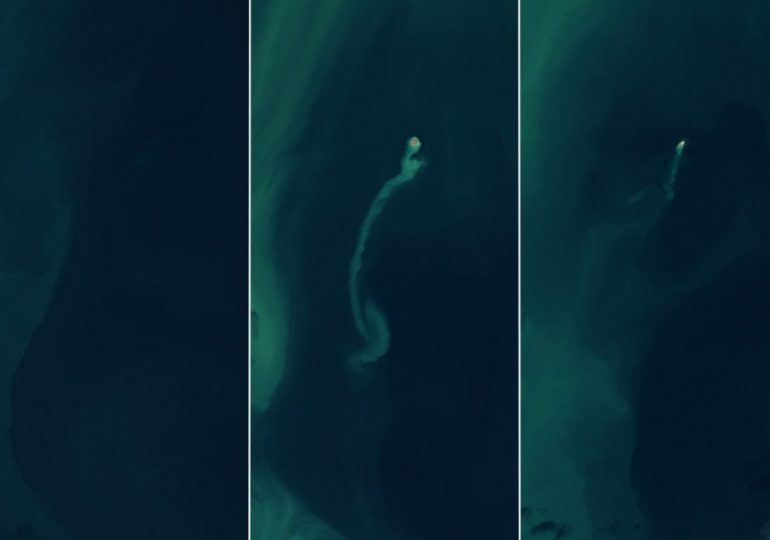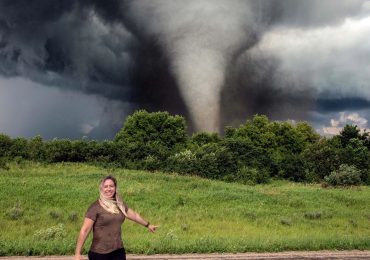NASA scientists have been left baffled by satellite pictures showing a “ghost” island appearing – and then mysteriously vanishing.
The “weird” sandy protrusion emerged in the Caspian Sea after a mud volcano erupted in early 2023.
SWNSThe cycle of the “ghost island” appearing and then vanishing was captured in these satellite images[/caption]
A closer look at the island and its sediment plume at the peak of its formationSWNS
SWNSAn artist’s impression of Nasa’s Landsat 8 satellite, which snapped the photos of the “ghost” island[/caption]
By then end of last year it had almost completely disappeared – dissolving away “like an apparition”, the Nasa Earth Observatory said.
The Operational Land Imager and OLI-2 sensing equipment mounted on the satellites Landsat 8 and 9 captured the images showing the island growing and shrinking 15 miles off the eastern coast of Azerbaijan, near the capital Baku.
The transient island formed around the site of the Kumani Bank mud volcano, also known as Chigil-Deniz, shortly after it erupted.
Scientists think the eruption spewed out enough solid material to form a temporary build up that stuck out above the water’s surface.
Similar ghostly islands have been spotted around the volcano since its first recorded eruption in 1861.
Nasa said: “A May 1861 event resulted in an island just 87 meters across and 3.5 meters above the water.
“This one eroded away by early 1862.”
This particular island’s lifecycle began in November 2022, when the crest of the volcano was still submerged.
After a flurry of volcanic activity, an island had risen above the water with a sediment plume trailing from it through the sea.
Mark Tingay, a University of Adelaide geologist, said that additional satellite observations suggest the island was formed between January 30 and February 14, 2023, and measured about 400 metres across.
By the end of 2024, only a tiny sliver of land at the Kumani Bank was visible above the water – and that will soon be gone too.
Mud volcano eruptions can be dangerous, with the potential to spew out large quantities of material, and even flames, in a short period of time.
Azerbaijan’s mud volcanoes are linked to the South Caspian Basin’s vast hydrocarbon system and are known to emit flammable gases such as methane along with the characteristic muddy slurries.
The area is unusual for its high frequency of mud volcano eruptions.
AlamyThe island formed near the site of a mud volcano like this one elsewhere in Azerbaijan[/caption]
SWNSAn artist’s impression of Nasa’s Landsat 8 satellite, which snapped the photos of the “ghost” island[/caption]
SWNSThe island can be seen in this picture about 15 miles off the east coast of Azerbaijan[/caption]
GettyThe 48-mile giant floating town Neft Dashlari in the Caspian Sea, Azerbaijan[/caption]
After a previous mud volcano eruption in 2021, Tingay said: “Azerbaijan has basically the perfect geological conditions for mud volcanoes.”
Nasa said: “Geologists have tallied more than 300 [mud volcanoes] in eastern Azerbaijan and offshore in the Caspian Sea, with most of those occurring on land.
“It is uncertain if the 2023 Kumani Bank eruption was fiery, but past eruptions of this and other nearby mud volcanoes have sent towers of flame hundreds of metres into the air.
“The region falls within a convergence zone where the Arabian and Eurasian tectonic plates are colliding,” the space agency added.
Tingay said in a seminar for the Geological Society of Australia that mud volcanoes are “weird and wonderful features that remain largely understudied and little understood”.
What is a Mud Volcano?
A MUD volcano is similar to a normal volcano, but it does not have any lava flowing through or out of it.
Lava is defined as molten or partially-molten rock.
They can vary hugely in size – coming as small as a few centimetres across to hundreds of metres high.
They can also form underwater as well as on land.
They are caused by water being heated up very deep within the Earth and then mixing with rocks and minerals.
When the pressure builds up this mixture is forced out through the earth’s crust in an eruption – and the material spewed out often catches fire.
It is not known exactly why mud volcanoes catch fire, but one theory is that a flammable gases from inside the earth are ignited by sparks from rocks colliding together.
Azerbaijan has the largest number of documented mud volcanoes in the world, with over 300 of them located in the country.
Getty – ContributorBilgah beach on Azerbaijan’s eastern coast with the Caspian sea, near where the island appeared[/caption]
Leave a comment








